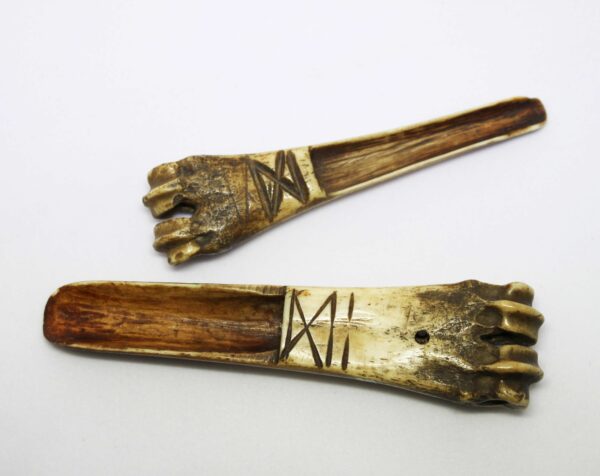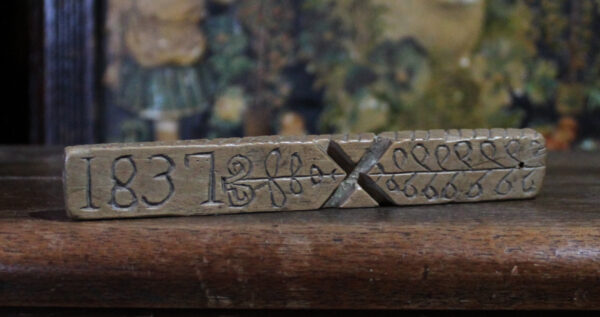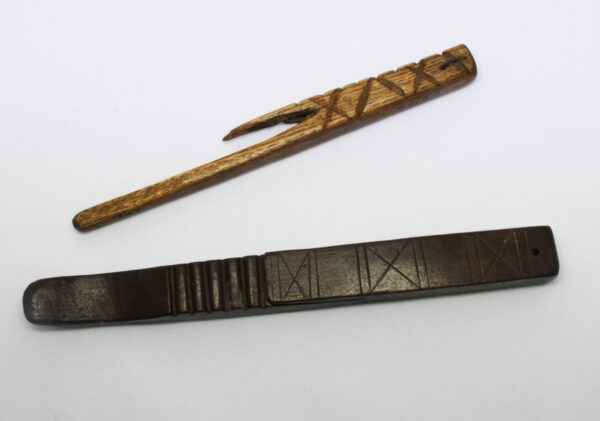Across the world, historic homes bear the marks of the past. Sometimes, this includes some very special marks which were deliberately inscribed as a form of protection. These symbols could be scratched, carved or even burned into buildings and their fabric, in the hope of warding off evil or trapping harmful spirits.
These protective markings, sometimes known as apotropaic marks, can still be found in homes, barns, and churches, although they are often overlooked, mistaken at times for graffiti.
X marks the spot!
One of the most frequently used protective symbols was the diagonal cross or ‘X.’ This simple but powerful mark was associated with safeguarding people and property. The belief in the protective power of crossing remains ingrained in modern culture—we cross our fingers for luck and mark hot cross buns with an ‘X’ at Easter.
It shows up in our collection on our famous ‘witch posts’, but can also be seen on a number of everyday objects, perhaps giving us clues about the areas of life where people felt vulnerable. This includes, apple scoops, carved from bone and used to help people to eat these hard-fleshed fruits.
Another common motif was the daisy wheel or hexafoil, a circular design often drawn in a single continuous motion. These were believed to trap malevolent spirits in an endless loop, preventing them from causing harm. Criss-cross patterns and mesh-like designs also appear frequently, possibly symbolising a barrier against evil forces.

Apple scoops from the collection at Ryedale Folk Museum
Where to look for protective markings
Protective symbols are most commonly found on doorways, windows, and fireplaces. These were viewed as potential entry points where spirits were thought to enter a home. Daisy wheel marks can be found on the door frame of our medieval Manor House, Harome Hall, which was relocated to the museum in the 1970s. In the case of witch posts, the marks adorn structural elements next to the chimney.
Interestingly, protective markings were not limited to buildings. Everyday objects also carried these symbols, offering personal protection. As well as apple scoops, other objects including wooden spoons and knitting sheaths can sometimes be found to bear protective carvings.
By the 17th century, handknitting was conducted using a curved metal needle. This held in place between the right hand and a sheath secured at the side of the body.
Most sheaths were not made by professional woodworkers. In fact, they were often carved as love tokens by a young man for his intended bride. They often have very distinctive designs, which vary according to region. Protective marking feature heavily within their symbols, as do hearts.


A selection of knitting sheaths featuring apotropaic x designs
The Legacy of protective markings
Nowadays, these traditions may seem distant. However, when we pause to consider the power of imagery, it’s clear that protective symbols remain part of our cultural heritage – how many of us still cross our fingers for luck? At Ryedale Folk Museum, we believe it is important to remember these folk beliefs, which give us a window into the lives and fears of our ancestors. In very uncertain times, when dangers must have lurked around every corner, be that illness, fire or famine, it’s understandable that ordinary people sought to protect themselves and guard against threats in their daily lives in whatever ways they could.
Throughout 2024, we worked with expert on ‘magical house protection’, Brian Hoggard to discover more about the special symbols on our objects and buildings. You can read more about this topic on Brian’s website, and report any markings or magical objects that you’ve found.
